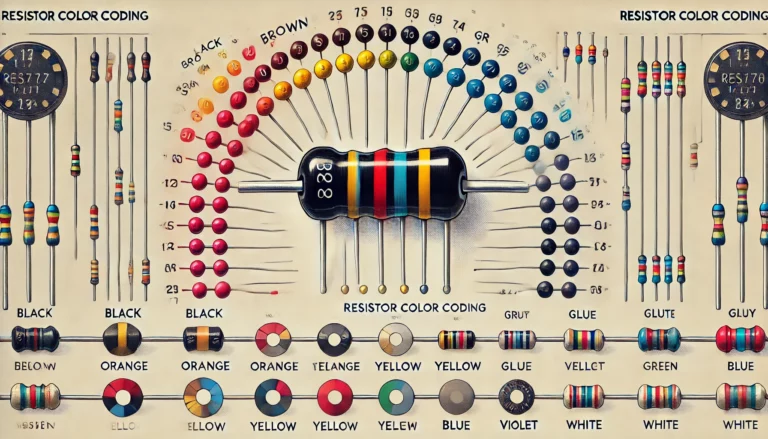Resistor Color Code Calculator: Simplify Your Electronic Projects
In the world of electronics, resistors are fundamental components that regulate the flow of current in circuits. Understanding the value of a resistor is crucial for designing and troubleshooting electronic circuits. However, reading resistor color codes can be challenging, especially for beginners. This is where a resistor color code calculator comes in handy. This guide will explore the benefits of using a resistor color code calculator, how to use it, and where to find the best ones online.

What is a Resistor Color Code Calculator?
A resistor color code calculator is an online tool designed to simplify the process of determining the resistance value of a resistor based on its color bands. Resistors typically have four to six colored bands, each representing a different value. A resistor color code calculator helps you quickly convert these colors into numerical values, saving time and reducing the potential for errors.
Why Use a Resistor Color Code Calculator?
1. Accuracy and Speed
Manually decoding resistor color bands can be prone to errors, especially when dealing with similar colors like red and brown or blue and violet. A resistor color code calculator eliminates this issue by providing accurate results instantly. Simply input the colors, and the calculator will display the resistor’s value, tolerance, and sometimes even the temperature coefficient.
2. Convenience for Beginners
For those new to electronics, memorizing resistor color codes can be daunting. A resistor color code calculator simplifies this learning curve, allowing beginners to focus more on their projects rather than getting bogged down by the technicalities of color codes.
3. Efficiency for Professionals
Even experienced electronics professionals can benefit from using a resistor color code calculator. It streamlines the process of reading resistor values, enabling professionals to work more efficiently and reduce the risk of mistakes in their designs.
How to Use a Resistor Color Code Calculator
Using a resistor color code calculator is straightforward. Here’s a step-by-step guide to help you get started:
Step 1: Identify the Color Bands
First, identify the color bands on the resistor. Most resistors have four bands, but some may have five or six. Hold the resistor with the tolerance band (usually gold or silver) to the right.
Step 2: Input the Colors into the Calculator
Open your preferred resistor color code calculator and select the colors corresponding to each band. Typically, you will input the first two or three significant figure colors, the multiplier color, and the tolerance color.
Step 3: Read the Result
Once you’ve selected the colors, the calculator will display the resistor’s value, including its tolerance. Some calculators may also provide additional information, such as the temperature coefficient for six-band resistors.
Finding the Best Resistor Color Code Calculators Online
There are numerous resistor color code calculators available online, each with its unique features. Here are some of the best options:
1. Digi-Key Resistor Color Code Calculator
Overview: Digi-Key is a well-known electronics components distributor, and their resistor color code calculator is one of the most reliable tools available. It’s user-friendly and provides accurate results quickly.
Features:
- Supports four, five, and six-band resistors
- Displays resistance value, tolerance, and temperature coefficient
- Mobile-friendly interface
Website: Digi-Key Resistor Color Code Calculator
2. All About Circuits Resistor Color Code Calculator
Overview: All About Circuits offers a comprehensive resistor color code calculator that is perfect for both beginners and professionals. The site also provides valuable educational resources on electronics.
Features:
- Supports four, five, and six-band resistors
- Detailed explanations of each color band
- Additional educational content and tutorials
Website: All About Circuits Resistor Color Code Calculator
3. Electronics 2000 Resistor Color Code Calculator
Overview: Electronics 2000 provides a simple yet effective resistor color code calculator. It’s ideal for quick look-ups and on-the-go calculations.
Features:
- Supports four, five, and six-band resistors
- Clear and straightforward interface
- Quick and accurate results
Website: Electronics 2000 Resistor Color Code Calculator
Additional Tips for Using Resistor Color Code Calculators
1. Double-Check the Colors
Always double-check the colors on your resistor before inputting them into the calculator. This helps avoid errors, especially with colors that are easily confused.
2. Understand the Basics
While a resistor color code calculator is a helpful tool, it’s beneficial to understand the basics of resistor color codes. Familiarize yourself with the color code chart and practice reading resistor values manually to build your skills.
3. Bookmark Your Favorite Calculator
Save time by bookmarking your favorite resistor color code calculator. This way, you can quickly access it whenever you need to decode a resistor’s value.
4. Use a Multimeter for Verification
If you’re unsure about the resistor’s value or want to double-check your results, use a multimeter. A multimeter provides an accurate reading of a resistor’s value, serving as a reliable verification tool.
Conclusion: Embrace the Convenience of Resistor Color Code Calculators
A resistor color code calculator is an invaluable tool for anyone working with electronics. It simplifies the process of decoding resistor values, ensuring accuracy and efficiency. Whether you’re a beginner just starting or a seasoned professional, using a resistor color code calculator can save you time and reduce the risk of errors in your projects. Explore the recommended calculators and integrate this handy tool into your workflow to enhance your electronic design and troubleshooting processes.




